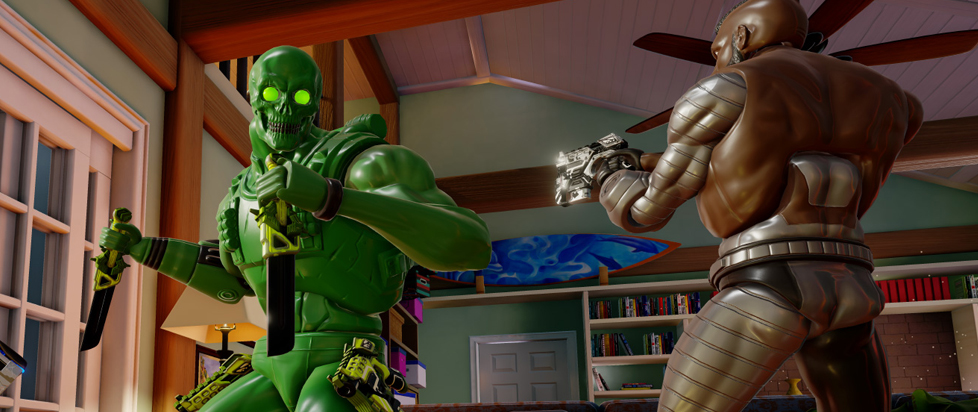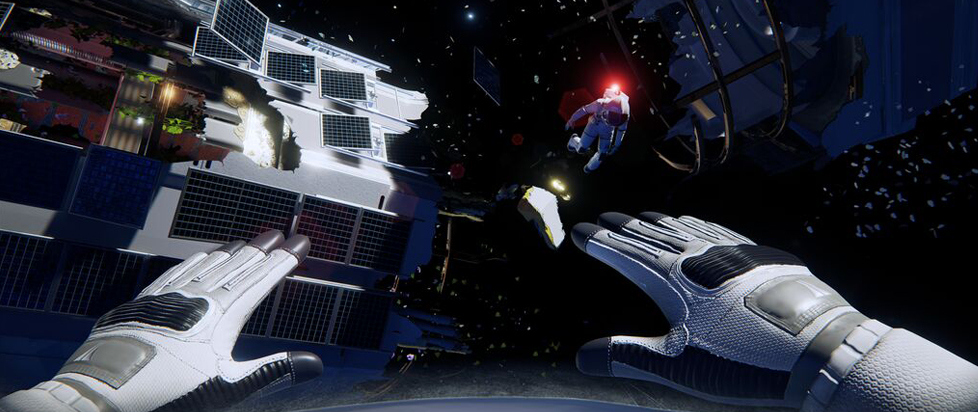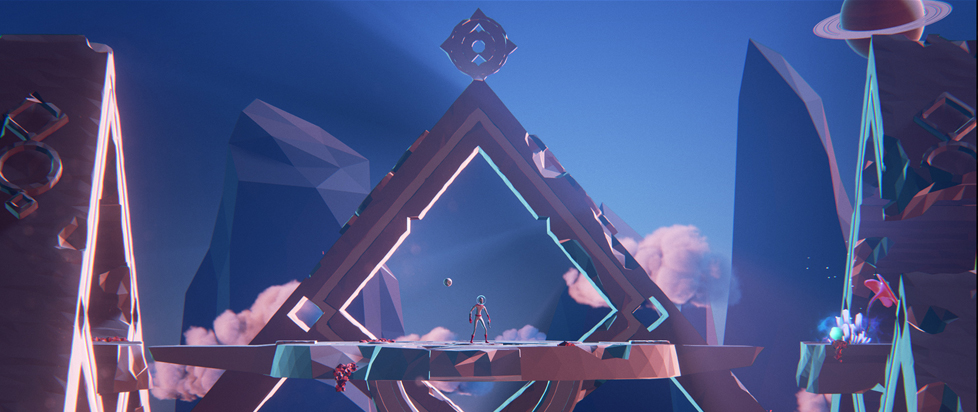
Revving the Engine: Hypercharge
 The following is a reprint from Unwinnable Monthly Issue Seventy-Six. If you enjoy what you read, please consider purchasing the issue or subscribing.
The following is a reprint from Unwinnable Monthly Issue Seventy-Six. If you enjoy what you read, please consider purchasing the issue or subscribing.
This series of articles is made possible through the generous sponsorship of Epic’s Unreal Engine. While Epic puts us in touch with our subjects, they have no input or approval in the final story.
———
Stacks of encyclopedias formed up into fortresses and ramparts. A bucket overturned was a fortified tower.
In what we called the TV Room, we had this brown plaid couch from the late 70s. Instead of a printed pattern on the upholstery, all these thick threads looping in and out of the material created the plaid design. Looking back, I am sure it was a sharp looking couch for its day, but as a kid, those loops were meant for one thing, and one thing only: hand holds for G.I. Joes. Their plastic hands, moulded in the shape of the letter C, slipped perfectly around the thread. Depending on the guys and the guns, I could put together a pretty dramatic battle on a sheer cliff face, or dangling off the side while clinging for life, or dozens of other scenarios.
The Rancor’s claws hooked onto those threads too, which resulted in a pose that was a convincing approximation of climbing. You know, if G.I. Joe vs. Cobra alone just wasn’t cutting it.
I can recall Saturdays when these battles would spread out through the whole house, my parents oblivious to the saga surrounding them – Mom reading, Dad watching TV. There were no separation between the toy lines – Shipwreck fought alongside Han Solo and Zodac against Major Bludd, Boba Fett and Mer-Man. Pieces from board games and other bits and bobs from around the house weren’t safe from similar conscription. The blocks from Crossbows and Catapults saw a lot of action. Bolts, nuts and pens became traps, mines and siege engines. The narrative was expansive. Anything was possible.
It was, I think, the kind of play that kids all over the world engage in, this theatre of the mind fuelled by toys and unfettered imagination. It was great.
Yet, until I came across Hypercharge, I had forgotten all about it.
Hypercharge is a first and third person cooperative multiplayer shooter in development by Digital Cybercherries – and it was born of the same kind of imaginative toy play I just described. Every player takes control of a highly customized action figure and, instead of a battlefield, they run havoc through a family home, over table tops, across the floor, up the stairs, even in the oven.
The available footage of the game inspires a profound nostalgia, not so much for a particular time or place, but for a state of mind that grows more remote with every passing year of adulthood.
Joe Henson, Digital Cybercherries’ community manager and public representative, took some time to chat with me about Hypercharge, nostalgia, customization and more.

I have to start with a couple questions about your first project, NewRetroArcade, because I think it is a fantastic, well-executed idea. In essence, it is a fully customizable 80s-era videogame arcade, complete with support for MAME, NES and SNES emulation, and a lot more. What were you hoping to accomplish with it?
NewRetroArcade is a tech demo built for virtual reality, specifically Oculus VR. We wanted to see how well Unreal Engine 4 worked for us in terms of its ease of use, its interface and its speed. The blueprint system was especially intriguing. NewRetroArcade was a way for us to test and learn the engine ahead of developing a full-fledged game. As developers coming from other game engines, we expected it to take some time to adjust to the interface, but after following a few tutorials online, everything just…worked. Everything fell into place so effortlessly we knew that Unreal Engine 4 was for us.
Can you walk me through the process of its development and the main take-aways of the experience?
Nothing compares to the speed of prototyping, testing and visual aspects of Unreal. We put a lot of love, care, time and effort into developing the arcade and Unreal Engine 4 allowed us to develop everything we wanted in an insanely short amount of time. We never once had to waste time “fixing” the underlying engine.
One thing that strikes me about NewRetroArcade is how powerfully nostalgic it is for someone like me, who remembers the arcades of the 80s. What is it about this particular era that inspires you? And, by the same token, why so you think it has such an enduring appeal to folks, even those who didn’t necessarily live through it?
The same thing that makes it appeal to you inspired us: how it truly felt to enter an arcade of that era. Hearing all the different sounds, seeing the flashing lights from the screens, smelling the pizza. It was a unique experience from a unique moment in time and we made NewRetroArcade with the hopes that it would help people relive it.
For people who didn’t experience those arcades first hand, I believe the same principle is still at work. Once they see the intricate details of NewRetroArcade, I hope they yearn for those experiences they never had.

The thing that I found immediately appealing about Hypercharge was just remembering playing with toys in the way depicted in the game. How are you going about capturing the phenomenon of being a kid at play?
None of us ever fully grow up; we never lose that desire to become immersed in our own imagination. Films like Toy Story and Small Soldiers play on that idea and I think they draw from a similar nostalgic longing – to recapture the freedom that comes with imaginary adventures. We think that an essential aspect of that experience is the creativity itself, which is why we think that extensive customization is essential. When you put that in the mix with solid gunplay and game-modes, I think we’re well on the way to capturing that experience.
What other games and media are you drawing on for inspiration?
We admire the combat of the Battlefield series and other realistic combat games. Alongside gameplay inspiration, we gather elements from all sorts of things, particularly the action figures, comics, cartoons and movies we grew up on. Our mood-boards are crammed with toys from the 80s and 90s, as well as figures you could pick up from a store today. Since we’re trying to create a focussed experience, some of these influences have more prominence than others, but you can expect a generous dose of nostalgia in Hypercharge.

Customization of the action figures is obviously important for you – how does it work? How deep are you hoping to get with it? How much of the gameplay is determined by customization (in that, it appears that certain heads, for example, change your power set, like the dude who shoots lasers from his head)?
Character customization is definitely a core part of the experience and it does sit at the heart of the game. We thought it was important to allow players as much freedom as possible to create a character which was very much their own. Without wanting to give too much away, I think there are many exciting customization options that we have yet to reveal.
It is a bit of kismet, perhaps, that this interview came as I have been happily making all my friends into XCOM soldiers – essentially making them action figures. What is it about customization that appeals to players?
Customization gives a feeling of progression – that the player can continue to achieve something and be rewarded in the process of doing so. There is a lot of satisfaction that comes from a design that you envision, that comes to life through just clicking a few buttons.
———
Stu Horvath is the editor in chief of Unwinnable. He reads a lot, drinks whiskey and spends his free time calling up demons. Sometimes, he plays with toys and calls it “photography.” Follow him on Twitter @StuHorvath.




